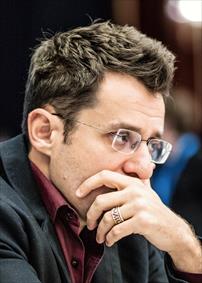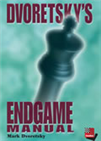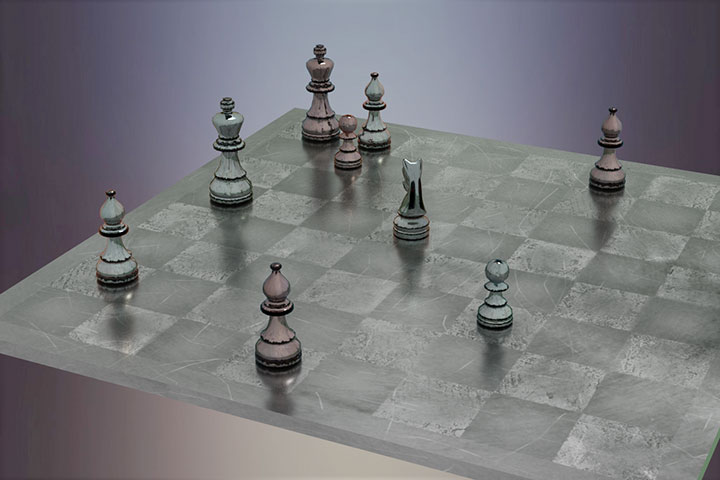Study of the Month: September 2019
 Despite the name, the FIDE Album is run by the independent but FIDE affiliated, World Federation for Chess Composition, which formerly was the FIDE Permanent Commission for Chess Composition. When it was invented at first, the FIDE Album was supposed to be a project to collect all best chess compositions throughout history, but a part of the proposed project was never finished, making retroactively the three 1914-1944 volumes the earliest entries so far. It's divided into the sections: Mate in 2, Mate in 3, Mate in 4+, Endgame Studies, Helpmate (h#2, h#3, h#4+), Selfmate, Fairy Chess, Retro and Mathematics.
Despite the name, the FIDE Album is run by the independent but FIDE affiliated, World Federation for Chess Composition, which formerly was the FIDE Permanent Commission for Chess Composition. When it was invented at first, the FIDE Album was supposed to be a project to collect all best chess compositions throughout history, but a part of the proposed project was never finished, making retroactively the three 1914-1944 volumes the earliest entries so far. It's divided into the sections: Mate in 2, Mate in 3, Mate in 4+, Endgame Studies, Helpmate (h#2, h#3, h#4+), Selfmate, Fairy Chess, Retro and Mathematics.
Not only is it a matter of time but also of money and of at least partial obsolescence by technology: At least with the rise of chess databases, the digitizing of private projects and the addition of new ones, there is a large number of chess problems and studies available online for free (examples: Schwalbe PDB, YACPDB) or paid (ex.: hhdbv as the most complete collection for endgame studies, WinChloé for all genres). Older enthusiasts might remember the cooperation of Harold van der Heijden with ChessBase for his second database in 2000, of which hhdbv is the October 2015 sequel, with a new database planned around 2021. (With his friendly permission I usually use the studies from his database as basis for the entries I present here.)
The currently available albums span 102 years of chess composition, from 1914 to 2015. Usually an album has a span of three years, and for the latest one is no exception. I served as director for section D (endgame studies). Appointed judges were Martin Minski (Germany), Richard Becker (USA), Ladislav Salai jr. (Slovakia). The director has to judge studies where at least one judge was the composer, but there were several cases where either two judges or a judge and me were involved, so a reserve judge had to be appointed who seems not to be named in the FIDE Album (from now on just “Album”). Our choice fell on Oleg Pervakov, GM for chess composition and co-author of the book “Studies for Practical Players” with Mark Dvoretzky. Of course, he had not much work — half a dozen of studies to judge — but his high level of expertise guaranteed a fair judgment. The scores of the individual judges are published in the FIDE Album for the published studies, in the order that they appear in at the front page of each section.
Each entry had to be rated on a scale from 0 to 4 by three judges, with steps of 0.5 points. For obvious reasons judges were prohibited from judging their own compositions, and also from seeing the scores of other judges prior to the scores being final. If an entry received 8 or more points, it would be included in the Album. Should fewer than a certain percentage of entries reach the threshold, it would be lowered to 7.5 points, as was the case this time. The statistics are very interesting and given at the end of the article.
 The highest ranked practical player in the Album is two-times World Cup winner (in practical chess) Levon Aronian. His first Album entry was confirmed in the same year as he married and won his second World Cup, 2017, showing him to be successful both in his private life and chess. After you watched the photos on the link above, you can see the study replayable below. The combination number (in this case D24) refers to the entry in the Album 2013-2015, while the addition (here 3+3.5+3) refers to the judges’ scores, the highest for a single study in this period being 11.5 out of possible 12.
The highest ranked practical player in the Album is two-times World Cup winner (in practical chess) Levon Aronian. His first Album entry was confirmed in the same year as he married and won his second World Cup, 2017, showing him to be successful both in his private life and chess. After you watched the photos on the link above, you can see the study replayable below. The combination number (in this case D24) refers to the entry in the Album 2013-2015, while the addition (here 3+3.5+3) refers to the judges’ scores, the highest for a single study in this period being 11.5 out of possible 12.
As you will notice, Oleg Pervakov and Karen Sumbatyan are co-authors of the study. Each entry in the Album gives points towards lifetime titles, similar to the practical titles but with the addendum “for Chess Composition”. A FIDE Master requires 12 points, International Master 25 points but a Grandmaster requires a much higher 70 points in the Albums, requiring a great number of high quality compositions, making it indeed a lifetime achievement. There also is a Honorary Master title but it is not related to FIDE Album inclusions. After many years, I have a bit over five points, but I did not participate in Albums prior to 2010-2012, thus likely missing a good chance for more points.
That said, it is very good that many composers do participate in the Album process (i.e. submitting their entries), and also in the “WCCI”, the World Championship in Composing for Individuals. The studies and problems there are judged similarly, so the rule was recently created that those WCCI entries with 8 or more points automatically qualify for the Album without being judged again. More information is found in last month’s article.
Statistics about the FIDE Albums
The following statistics are taken from the FIDE Album 2013-2015 and are printed as diagrams or tables with a complete historical information there: A total of 25,530 compositions was included in all Albums spanning the time from 1914 to 2015. Of these, 3,007 are endgame studies. For the following statistics, only the three year periods are looked at (since 1956-58): The highest number of endgame studies was included in 1962-64 (161), the lowest in 1956-58 (70).
The 2013-15 Album contains 107 endgame studies. Among the entire Album selection 2013-15, retro and mathematical problems (together in a single category) have a clearly highest inclusion rate by percentage (i.e., selected vs. evaluated problems) at around 24.48 percent (second highest: Selfmates, 17.26 percent) but lowest at actual numbers (83).* Helpmates have the lowest percentage at 11.81 percent, studies follow with 12.83 percent. Of the 9,988 total compositions sent for evaluation, 1,499 were included in the Album, making it the most in a three years period.
*This reflects in my opinion the overall high quality of such problems, but the genre is difficult to understand at first for practical players. The books by Raymond Smullyan in my opinion offer a good introduction but are difficult to find.
Indeed, sometimes I look at the fairy or retro problems and just can’t believe that someone can come up with those crazy constructions. To me, retro chess is a miracle, having positions — looking very unnatural to the layman — where dozens of previous moves are determined. When you look at such problems (to give the ultimate example in this Album) like Dimitry Baibikov’s H26, a retro problem where moves are retracted under specific “battle” rules, so White can prove he had the ability to checkmate in one move not more than 187(!) moves ago... I can’t even begin to comprehend how this is composed. But that is the beauty of chess — there always is something to see that you never saw before. Chess is larger than life in the sense that (from a mathematical perspective) there is far more than can be seen in a lifetime.
Next month, we plan to conclude this miniseries by looking at the WCCTs (World Chess Composition Tourneys), also presenting some interesting studies from them. This month, you can replay studies selected from the current FIDE Album below. If you look at the first part of this miniseries, you can replay some WCCI (not to be confused with the WCCT) studies and learn about the World Congress for Chess Composition.
Many thanks to WFCC President Harry Fougiaxis for correcting my draft for this month! Any possible mistakes left were too well hidden by your author.
Click or tap an entry in the list to switch positions
You probably know that you can move pieces on our replay boards to analyse and even start an engine to help you. You can maximize the replayer, auto-play, flip the board and even change the piece style in the bar below the board.
At the bottom of the notation window on the right there are buttons for editing (delete, promote, cut lines, unannotate, undo, redo) save, play out the position against Fritz and even embed the ChessBase game viewer on your website or blog. Hovering the mouse over any button will show you its function.
Bonus: Is the FIDE Album suitable for you? What books are suited for beginners?
Of the many beautiful compositions, only the very best are supposed to be in the FIDE Albums. But there are more problems and studies worth looking at. Any anthology can only be a suggestion, a selection, never a comprehensive overview, never suited for all tastes or circumstances. The FIDE Albums aren’t aimed at practical players, but at the knowledgeable chess composition audience. Some entries can be fun or interesting for players, but most have nothing to do at all with practical games, additionally some are only great if you are willing to analyze them in full, to take the time to fully understand them, but possibly where a certain knowledge already is necessary to appreciate them. In a way, the beauty of the Immortal Game for players is what composers strife for, to create something that is incredible, that is appreciated by the enthusiasts. But whereas Anderssen and his opponent enjoyed the battle of the wits, for the composer there is no such restriction, enabling far more ideas.
 Russian International Master Mark Dvoretsky is perhaps the most respected chess instructor in the world today. His latest work, Dvoretsky’s Endgame Manual, is sure to become a classic on one of the most difficult and subtile phases in chess. It covers all the most important positions required for endgame mastery, from elementary king-and-pawn endings to complex rook or queen endgames that have baffled even top grandmasters.
Russian International Master Mark Dvoretsky is perhaps the most respected chess instructor in the world today. His latest work, Dvoretsky’s Endgame Manual, is sure to become a classic on one of the most difficult and subtile phases in chess. It covers all the most important positions required for endgame mastery, from elementary king-and-pawn endings to complex rook or queen endgames that have baffled even top grandmasters.So for the purely practical player, possibly looking to improve his strength, it won’t make much sense to get a FIDE Album, even if he is willing to solve the problems and studies. Other literature would be more suited in your humble author’s opinion, and a good book about endgame studies would be much more recommended for those wanting to take a peek into the artistic territory. Dvoretzky’s Endgame Manual would be one work teaching the endgame with practical games and endgame studies, providing incredible value. The artistic side can be rather explored with for example “Test Tube Chess” by John Roycroft, or possibly the freely available EG archive. Also see below.
For chess problems, there are other great works that can introduce players to mate puzzles. But that would be beyond the scope of this article. Here on ChessBase many articles and the Christmas puzzles are a good start for those that don’t want to read about the theoretical basics.
Unfortunately, I lack the deeper knowledge to recommend problem books for interested readers (other than studies), but the “Schwalbe-Bücherwart” (Schwalbe bookkeeper) Ralf Krätschmer (e-mail) thankfully agreed to help interesting readers, so feel free to contact him or discuss good books in our comments.
For readers fluent in German language, Ralf recommends:
- Schach ohne Partner (Herbert Grasemann)
- Problemschach 407 Aufgaben und Studien (Hoffmann/Schiller/Sehndel/Zucker)
- Schach für Nußknacker (Friedrich Chlubna)
- Problemschach für Schachspieler (PDF) (Zierke, free download link by Ralf Krätschmer)
This is of course by far not an exhaustive list, and I can recommend for endgame studies “Studies for Practical Players” by Dvoretzky (but is biased because he has a study in it) as well as several books by Yochanan Afek, who due to his expertise in both fields understands to show studies that are interesting to players. “Secrets of Spectacular Chess” by Levitt and Friedgood might be aimed at experts, but can also serve as a guidebook on what or what not is usually seen as aesthetical. Many combinations in games, even if spectacular, might not be suitable for studies. But sometimes a rare gem occurs in a game that is further shaped by the player or a composer who sees it. This interesting topic however might require an own article in the future, provided enough material is found.
The FIDE Albums are meant as anthologies of the very best studies and problems, as collections to browse through and admire, and would still be recommended if it wasn’t for the necessarily rather high price due to the high production value for those interested to see an overview of modern chess problems who already have a certain knowledge; the other books would rather be meant for those new to chess composition. In the end, there are few bad books, as most are written by enthusiasts. While I made a few regrettable mistakes in it, you can also have a look my free e-book “Weltenfern” in English, which however has only the originals available in a separate PGN file, not all the content. Sadly I never had the motivation to translate it into German or write another book.
Perfect endgame analysis and a huge increase in engine performance: Get it with the new Endgame Turbo 5! This brings the full 6-piece Syzygy endgame tablebases on a pendrive. Just plug it in a USB socket and you are set!

World Federation for Chess Composition (www.wfcc.ch)
Links


















 Despite the name, the FIDE Album is run by the independent but FIDE affiliated, World Federation for Chess Composition, which formerly was the FIDE Permanent Commission for Chess Composition. When it was invented at first, the FIDE Album was supposed to be a project to collect all best chess compositions throughout history, but a part of the proposed project was never finished, making retroactively the three 1914-1944 volumes the earliest entries so far. It's divided into the sections: Mate in 2, Mate in 3, Mate in 4+, Endgame Studies, Helpmate (h#2, h#3, h#4+), Selfmate, Fairy Chess, Retro and Mathematics.
Despite the name, the FIDE Album is run by the independent but FIDE affiliated, World Federation for Chess Composition, which formerly was the FIDE Permanent Commission for Chess Composition. When it was invented at first, the FIDE Album was supposed to be a project to collect all best chess compositions throughout history, but a part of the proposed project was never finished, making retroactively the three 1914-1944 volumes the earliest entries so far. It's divided into the sections: Mate in 2, Mate in 3, Mate in 4+, Endgame Studies, Helpmate (h#2, h#3, h#4+), Selfmate, Fairy Chess, Retro and Mathematics. The highest ranked practical player in the Album is two-times World Cup winner (in practical chess) Levon Aronian. His first Album entry was confirmed in the same year
The highest ranked practical player in the Album is two-times World Cup winner (in practical chess) Levon Aronian. His first Album entry was confirmed in the same year 





